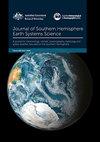东海岸低气压与澳大利亚东海岸降雨的时空变化之间的联系
IF 3.6
4区 地球科学
Q1 Earth and Planetary Sciences
引用次数: 0
摘要
东海岸低压(ecl)是发生在南半球和北半球大陆副热带东海岸的强烈低压系统。ecl通常与大风、巨浪、风暴潮、暴雨和洪水有关。虽然ECL的影响通常被认为是负面的,但与ECL相关的降雨对人口稠密的澳大利亚东部沿海地区的城市水安全也非常重要。本研究通过对历史ECL的研究,了解ECL发生的时间、频率、强度和位置,以及ECL对降雨的影响程度和空间范围。强调了与不同ECL子类型相关的不同特征和影响,并提出ECL行为的时空变异性至少部分解释了为什么欧空局与澳大利亚其他地区的水文气候不同,以及为什么欧空局内不同地点的降雨模式如此不同,因此洪水和干旱风险水平也不同。这些见解对于新南威尔士州政府资助的东海岸气候变化倡议(ESCCI)的目标至关重要,特别是关注ecl对水安全影响的项目5。这项工作的结果将用于产生气候信息的随机日降雨量模拟,这种模拟比现有的随机降雨模拟方法在保留流域尺度水文学重要统计数据(例如,极端事件的聚类、长期持久性、干湿期的频率/持续时间/幅度)方面更现实。这些模拟的降雨序列包含了由ecl和其他气候现象引起的时空水文气候变率,是用于确定欧空局内当前和未来城市水安全的水文模型的重要输入。本文章由计算机程序翻译,如有差异,请以英文原文为准。
Links between East Coast Lows and the spatial and temporal variability of rainfall along the eastern seaboard of Australia
East Coast Lows (ECLs) are intense low-pressure systems which occur over the subtropical east coasts of southern and northern hemisphere continents. ECLs are typically associated with gale force winds, large seas, storm surges, heavy rainfall and flooding. While ECL impacts are typically seen as negative the rainfall associated with ECLs is also very important for urban water security within the heavily populated eastern seaboard of Australia (ESA). This study investigates historical ECLs to gain insights into the timing, frequency, intensity and location of ECL occurrence as well as the magnitude and spatial extent of ECL impacts on rainfall. The different characteristics and impacts associated with different ECL sub-types are highlighted and it is proposed that this spatial and temporal variability in ECL behaviour at least partially explains why the ESA is hydroclimatically different to the rest of Australia and why different locations within the ESA have such different rainfall patterns—and therefore different levels of flood and drought risk. The-se insights are critical to the objectives of the New South Wales government funded Eastern Seaboard Climate Change Initiative (ESCCI), in particular Project 5 which focuses on the water security impacts of ECLs. The results of this work will be used to produce climate-informed stochastic daily rainfall simulations that are more realistic than existing stochastic rainfall simulation methods at preserving the statistics important for catchment-scale hydrology (e.g. clustering of extreme events, long-term persistence, frequency/duration/magnitude of wet and dry spells). These simulated rainfall sequences, that incorporate the spatial and temporal hydroclimatic variability caused by ECLs and other climate phenomena, are important inputs into the hydrological models used to determine current and future urban water security within the ESA.
求助全文
通过发布文献求助,成功后即可免费获取论文全文。
去求助
来源期刊

Journal of Southern Hemisphere Earth Systems Science
Earth and Planetary Sciences-Oceanography
CiteScore
8.10
自引率
8.30%
发文量
0
审稿时长
>12 weeks
期刊介绍:
The Journal of Southern Hemisphere Earth Systems Science (JSHESS) publishes broad areas of research with a distinct emphasis on the Southern Hemisphere. The scope of the Journal encompasses the study of the mean state, variability and change of the atmosphere, oceans, and land surface, including the cryosphere, from hemispheric to regional scales.
general circulation of the atmosphere and oceans,
climate change and variability ,
climate impacts,
climate modelling ,
past change in the climate system including palaeoclimate variability,
atmospheric dynamics,
synoptic meteorology,
mesoscale meteorology and severe weather,
tropical meteorology,
observation systems,
remote sensing of atmospheric, oceanic and land surface processes,
weather, climate and ocean prediction,
atmospheric and oceanic composition and chemistry,
physical oceanography,
air‐sea interactions,
coastal zone processes,
hydrology,
cryosphere‐atmosphere interactions,
land surface‐atmosphere interactions,
space weather, including impacts and mitigation on technology,
ionospheric, magnetospheric, auroral and space physics,
data assimilation applied to the above subject areas .
Authors are encouraged to contact the Editor for specific advice on whether the subject matter of a proposed submission is appropriate for the Journal of Southern Hemisphere Earth Systems Science.
 求助内容:
求助内容: 应助结果提醒方式:
应助结果提醒方式:


